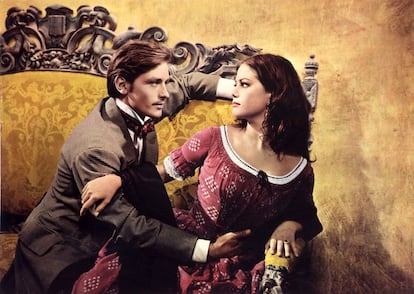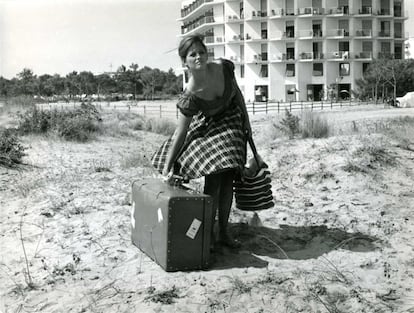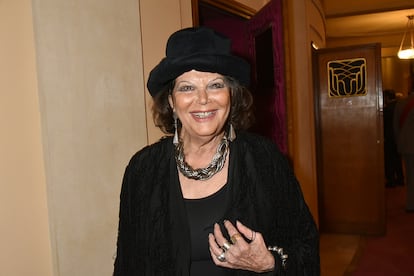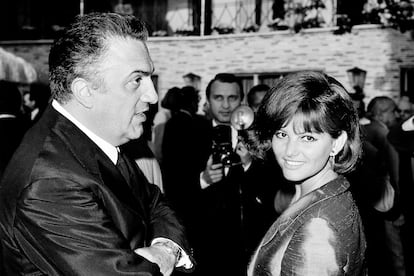The vouchers of The catpardoits appearance floating in the summer light in Eight and a halfwhile Mastroianni looks at her fascinated above the sunglasses, or the captivating princess of The pink panther They are some of the images that Claudia Cardinale, who died on Tuesday at age 87, leaves in the history of cinema. These three big films are all of the same year, 1963, and that was at the three at the same time in cinemas around the world give an idea of the impact of the emergence of the beauty and natural talent of Claudia Cardinale on the screens. It would only have been shot one of those films to be a star, but also made 130 films that made it a myth of world cinema in the golden age of Italian cinema. He worked with the greatest: Visconti, Fellini, Germi, Monicelli, Leone, Gance, Edwards, Hathaway, Brooks … with her one of the last great actresses of those years leaves, only Sophia Loren remains.
Cardinale has died at her home in Nemours, near Paris, as announced by her agent, Laurent Savry, to the AFP agency on Tuesday night. He had installed there years, and France was one of the three countries of his life. In addition to Italy, the other, the first, was Tunisia, where he was born in 1938, when he was a French protectorate, in a family of Sicilian immigrants. His first memory was the arrival of American soldiers in war. In Tunisia he discovered for the cinema a French director, René Vautier, who saw her in front of his school and was fascinated. “He approached me and told me if I could talk to my father,” he said in an interview. Signed it for a short film, Golden Ringswhich triumphed in Berlin, and then won, without knowing it, a beauty contest in which the most beautiful in Tunisia was proclaimed. The prize was a trip to the Venice Mostra, and so it all started in 1957. There he told photographers that he did not want to make movies, but something must have felt at the festival with one of the first films he saw in a cinema in his life, The white nightsfrom Visconti. Only three years later he would act in one of his films, another masterpiece, Rocco and his brothersand was one of the directors who first knew how to intuit a great actress.
His entrance to the cinema is with 20 years, when he first appeared in a feature film, and it was already a masterpiece: Rufufu (1958), Monicelli’s comedy about ducky and hungry thieves. He then confessed that he spoke Italian with difficulty and barely understood all those people who shouted in the filming (“I thought they argued,” he said). Although just a few minutes, it was a snatching presence and immediately began to make its way in the cinema.
The producer of that film, Franco Cristaldi, became years later in his first husband, although after separating his partner for many years he was Pasquale Squitieri, another Italian filmmaker, with whom he had a son. But in that same year of his first film, 1958, he had given birth to his first child, a painful hidden story that was known years later: it was the result of a rape, and decided to have the child. For years he presented it as his brother, until he revealed his story in an interview. In that year he rolled three films hiding his pregnancy. He told Cristaldi, thinking he would throw her out, but he paid a trip to London to give birth in great secret. There was born his relationship.

Until her year of Gloria in 1963 she signed impeccable films, as great directors claimed her right away and trusted her in increasingly complex roles. In those titles, which are now worship, it was leaving a mark, with dramatic records and a melancholy background, and a very versatile actress was demonstrated, capable of everything, also in comedy. They were films like A damn mess (1959), De Germi; The beautiful AntonioDe Bolognini, with Mastroianni; Rocco and his brothers (1960), from Visconti, and The girl with the suitcase (1961), by Zurlini.
When Fellini called her to Eight and a halfhe was as pledged to her as it was that in the film Claudia Cardinale almost herself, she shows how she is, cheerful and casual. In fact, some scenes represent moments and conversations that occurred in reality with Fellini, which in the film is his alter ego Mastroianni. Visconti consecrated her with her role in The catpardoin which he made one of the most beautiful couples in the history of cinema with an Alain Delon with a pirate patch in the eye, and also with a Burt Lancaster, in the final dance, which represented the end of an era. It is incredible to think that he filmed the two films at the same time, going and coming from Sicily to Rome, with two totally opposite filmmakers ―Visconti, maniac of the script and precision; Fellini, chaotic and was inspired by improvisation. It is that even in a film he was blonde and in the other, Morena.

Faced with these two monuments of Italian and world cinema, also in 1963 it is their role in the delicious comedy The pink pantherby Blake Edwards, the first title of the flashing saga of Inspector Clouseau, which makes it known in Hollywood. In the big studies he did everything, but he never allowed himself completely by American cinema, he always returned to Europe. In those years he worked with the most famous actors of the moment, such as John Wayne, Sean Connery, William Holden, Henry Fonda, Orson Welles, Anthony Quinn, Laurence Olivier or Burt Lancaster. He rejected a long line of gallants and suitors, starting with Mastroainni and Delon, of which he became very good friend, and Marlon Brando, among others. In an interview of his last years he also died of laughter by denialing an already classic rumor in France, that he had a story with Jacques Chirac.
In the United States he left good films, such as Professionals (1966), from Brooks, and Until his time came (1968), Sergio Leone’s final western. It also appeared in Fitzcarraldo (1982), from Herzog, and in one that they always put a lot in Spain, The oil companies (1971)shot in our country, with Brigitte Bardot, at the time when both were the two sex symbol Europeans (BB against CC) and where José Luis López Vázquez sneaks among them. One of his last roles was in The artist and the model (2012), by Fernando Trueba.

His daughter made a book about her life and her career she called Claudia Cardinale, the indomablea title that she liked, because all her life had sought independence and had moved freely: “The indomitable word is fine.”

